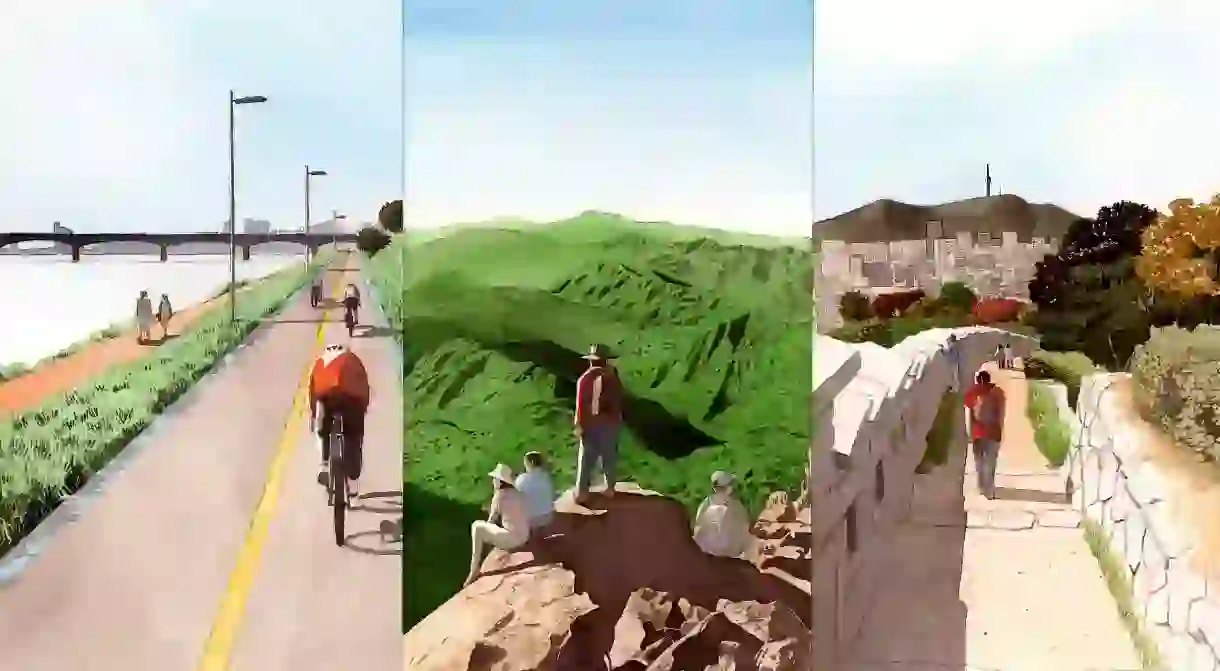A Guide to Outdoor Adventures Across Korea

South Korea’s thriving pop culture, hi-tech exports and bustling metropolises are justifiably world-famous. But scratch the shiny, neon surface of this intriguing destination and you’ll discover another side to the country that’s often overlooked. Across the peninsula, rolling mountains, sandy coasts and lush forests beckon those eager to explore the great outdoors. And with a host of bike paths, hiking trails and campsites, Korea isn’t just beautiful – it’s an adventure-lover’s paradise.
Striking biking experiences
With more than 1,700km (1,0561mi) of dedicated cycling paths that cover the entire length of the country, South Korea is arguably the most cycle-friendly nation in Asia.
Perhaps the most accessible route is the Hangang River Cycling Trail, a 310km (193mi) path that runs through a dozen parks along the Han River. Paved and mostly flat, the path offers an easy ride – and a unique way to see the city and its surrounding areas. You can hop on the path anywhere along the river, and if you don’t have your own bike, begin your journey in Yeouido Park where you can rent one.

If you fancy a week-long journey, consider taking all or part of the 4 Rivers Trail. This network of cross-country cycling paths stretches some 600km (370mi) from Incheon to Busan past urban cityscapes, historical sites and bucolic countryside. The infrastructure is expansive and luxurious: there are restrooms every few kilometres, rest stops with bike racks, cycle-only tunnels and on-trail convenience stores.
While the mainland has its fair share of paths, cyclists shouldn’t miss the opportunity to experience a trip around subtropical Jeju Island. Winding 234km (145mi) along the coast, the Fantasy Bike Path takes riders past the Jeongbang and Cheonjeyeon waterfalls, the hipster-friendly Woljeongri Beach in Gujwa-eup and Seongsan Ilchulbong, also known as Sunrise Peak.
Although experienced cyclists can circumnavigate the entire island in 12-14 hours, the recommended time is 4-8 hours a day over the course of a few days. This is Jeju, after all, and you’ll certainly want to enjoy the quaint cafes and coastal scenery along the way. Wherever your biking journey takes you, the Korea Cycling Network Facebook group is a great resource for additional information.

Epic trails
Mountains cover more than 70 percent of South Korea, so there’s no shortage of trails in this hiking-crazed country. Whether you’re a novice trekker or veteran mountaineer, there’s a course for just about everyone, each offering unique scenery that transforms from season to season.
Most tourists flock to Seoraksan and Bukhansan Mountains, yet the more isolated Juwangsan National Park is a great alternative for those looking to escape the crowds. Craggy cliffs, glistening waterfalls and the mystical willow-edged Jusanji Pond are the highlights of this nature retreat, which provides the perfect backdrop for a weekend of hiking in semi-solitude. While you’re here, sample the apple-flavoured makgeolli, a Korean rice wine and hiking staple.
Jirisan National Park, the first and largest national park in Korea, also warrants a visit. Trails range from a short, hour-long promenade to a multiday hike that includes spectacular sunrise views. With seven major Buddhist temples and ancient stone carvings, there’s much to see and explore here.

Sleep beneath the stars
Camping in Korea is convenient, safe and anything but run-of-the-mill, with options that are sure to surprise even the most seasoned of campers.

Take the National Land Administration Central Observatory in Yanggu, just south of the Demilitarized Zone. The planetarium provides visitors with an opportunity to learn about the stars, then sleep underneath them. The night skies here are especially beautiful, as the surrounding area is uninhabited, so there’s almost no human-created light to disrupt your stargazing. The Jungmisan Observatory in Yangpyeong offers a similar experience closer to Seoul.
Wildlife lovers shouldn’t miss the Samnak Ecological Park Camping site on Busan’s Nakdonggang River. It’s home to countless wildflower colonies, and migratory birds settle here in winter to pass the cooler months. If sand is more your thing, head to Yulpo Beach, a short drive from Boseong’s green tea plantations, to spend the night after a day’s trek through the fields. Or, take a bus from Incheon to the mud flats of Muuido Island. Not only are the sunsets here spectacular, you can actually forage for your dinner – clams abound at low tide.
For a more luxurious getaway, book a spot at Florence Glamping in Gapyeong or one of the stylish geometric domes at Banu Glamping in Hongcheon. Each offers a serene nature hideaway with all the comforts of home.

Walks with a view
Sometimes just being present in nature’s wonders is enough to complete an outdoor adventure. To enjoy unmatched vistas of coastal scenery, plan a trek on the Jeju Olle Trail, a series of 26 walking trails that snake around the perimeter of Jeju Island.

Conceived by former journalist Suh Myung-suk, who walked and was inspired by the Camino de Santiago in Spain, the Olle Trail passes through small villages, beaches, farms and forests, and provide a unique look into the natural and cultural beauty of Jeju. Trails are organised by level of difficulty and well-marked trail signs make them easy to navigate. Routes one, six and seven are considered the best for first-timers, as they take visitors through a number of cultural sites, waterfalls and oreum (volcanic cone) hiking spots.

If you’re staying in Seoul, lace up your walking shoes and head to the Fortress Wall. Built during the Joseon Dynasty, to defend and mark the city boundaries in 1396, it stretches 18.6km (11.5mi) around the heart of the city. The ancient fortress twists through a number of neighbourhoods including Dongdaemun, Ihwa Village and off-the-beaten-track Buam-dong, and even continues along a number of Seoul’s mountains, providing magnificent cityscapes. It is a great place to see the juxtaposition of old and new, and an ideal setting to escape the busy city streets – if only for an afternoon.

To discover even more about Korea’s compelling culture and to start planning your trip, visit english.visitkorea.or.kr













